
ARCHIVED PAGE - PLEASE READ!
This page was written by me a long, long time ago. As such the quality of the writing, photography and/or any conclusions I may have come to simply do not stand up to the levels I consider necessary these days.
I do not believe in deleting things outright though as I feel that these pages form something of a time capsule from an earlier stage in my life, and may still be of some interest to folks who have been coming here for a long time. So instead of deleting this page it has been archived.
PLEASE NOTE THAT THIS PAGE HAS BEEN ARCHIVED, AND SHOULD BE CONSIDERED "FOR INTEREST ONLY" AND NOT BE USED FOR ANY OTHER PURPOSE. LINKS, PRICING ETC ARE LIKELY TO BE OUTDATED AND WILL NOT BE UPDATED.

Maglite are probably the best known maker of flashlights in the
world. They have a good deal of respect even among us enthusiasts
for making well put together, durable lights. However until quite
recently they did have one real drawback. Their mainstay models
really were starting to look rather obsolete in the opening years of
the 21st century, for one very simple reason: They have been very, very
slow to embrace LED technology.
The smaller models in particular suffered heavily where the shock
resistance and higher efficiencies were most obvious and gave LED
lights a truly massive advantage. There were
a slew of lights which could run rings around their 2AA model for both
runtime and output as white LED lights started to become more
common. In fact, there were several commercially produced kits
which allowed the popular Mag 2AA to be converted to LED operation that
appeared on the market a few years ago, such was the opinion of people
that "it's a great light...just wish it was LED based." The 1AAA
"penlight style" Solitaire was all but ground into dust by the likes of
the Arc AAA (one of which has been on my keychain now since around 2003
and is still going strong) on account of it's candle-like light output.
It appears however, that they have finally seen the light (pun
absolutely intended...) and now have quite a number of LED models
available in most of their "Classic" form factors from 2AA upwards
(I've no direct experience with these lights yet however, so can't
really comment on how they perform), in addition to several new, more
original models. The XL100 reviewed here is quite a radical
departure from Mag's usual very traditional approach to design; looking
somewhat like a Mag Solitaire on steroids, and sporting a rather
innovative switching system. While I approached it with quite
some scepticism, I really quite like it.
Can it really be true? Can Maglite have really gone and broken
the mould...and actually come up with a winner? Let's find out,
shall we...

| Manufacturer | Mag instruments Incorporated |
| Available From | Various websites/Stores. Review example purchased from Target |
| Price (At time of writing) | USD 39.99 (Plus tax) as of July 2010. |
| Size | 122 x 25mm |
| Number of Lamps | 1 |
| Lamp Type | Rebel 091 LED |
| Peak Beam Intensity (Manufacturer's Claim) | 4484cd |
| Total luminous Flux (Manufacturer's Claim) | 83Lm |
| Lamp Current | Unknown - Unable to Measure |
| Lamp Colour | White |
| Body Finishes Available | Anodized aluminium. Black (As reviewed), also available in red, silver, blue and grey |
| Battery Type | 3 AAA Cells (Duracell alkaline cells provided). |
| Battery Life | 201 hours on low, 5 hours on high. (Manufactuers Claims) |
| Switch Type | Tail mounted push button and motion sensor |
| Water Resistance | Water resistant - no depth rating given. |
| Approximate Beam Angle | Not yet measured |
| Notes: | Covered by a limited lifetime warranty. Supplied with instruction leaflet and 3AAA size Duracell cells only - No other accessories. |
| Review Date | 11th June 2010. |
| Related Pages | None at this time. |
First Impressions.
This is the first time that I've actually had a chance to look at a
product from Mag which is completely new, so it's really interesting to
get a look at what their design team can do when they actually drag
themselves into the 21st century and make use of all the technology in
front of them.
The light comes on a green card-backed plastic blister package as with
most of their retail models. This is a particularly sturdy sonic
welded package, and is a complete pain to get into - if you don't have
access to a pair of sharp scissors or a craft knife, I wish you
luck! I'd discourage the use of flamethrowers or explosives
however, as that would probably void the warranty...

Once you do finally manage to get into the package - and assuming that
you haven't sent the light flying off across the room and the batteries
scattering in all directions - first thing you may well notice will be
how light it is until you put the batteries in. It doesn't really
feel flimsy or anything, just oddly light! It is a mass produced
product, so the fact that Mag have cut down the amount of metal they've
used as far as they can without unreasonably compromising the
durability isn't all that surprising.
In the package with the light itself is a brief set of instructions
(the backing card folds out), and a set of Duracell AAA
batteries. It's worth noting however that these aren't taped in
or anything...so if you're an idiot like me, they may go rolling off
over the floor when you take the light out.
First impressions visually are, as I mentioned above in the
introduction, that the light looks very much like a giant Mag Solitaire
in terms of its actual proportions and styling. I guess however
that anything with that sort of aspect ratio, a glossy anodised finish
and groves running along the length of the body do to some extent
though given what a ubiquitous light it is. I do actually have a
couple of them rattling around in a box somewhere...if I can track one
down, I'll snap a photo of this light next to one sometime.

Overall fit and finish seem to be precisely what you would expect from
a company who've been around as long as Mag and pride themselves on a
reputation for making a mass produced, but decent quality product:
Overall very good. There are no rough edges on any machined
parts, all threads turn smoothly etc and are properly lubricated, as
are the waterproofing O-rings. The markings throughout the light
are all laser-etched and are properly aligned, complete and
crisp. The entire thing appears to be anodized, inside and out,
with nothing having been missed.
The only let down at all is the plastic lens, which on my sample has a
couple of marks on it. Nothing that's the end of the world...but
it's still a shame that they didn't apply as much attention to detail
to that as they did to the rest of the light in terms of quality
control. First impressions count for a lot, and it's a bit of a
shame that a couple of little scratches on the lens mar what otherwise
really looks and feels like a quality product. Still...overall
this is a minor detail, and I'm sure that Mag would happily send me a
replacement lens if I asked - which I shall be doing shortly.
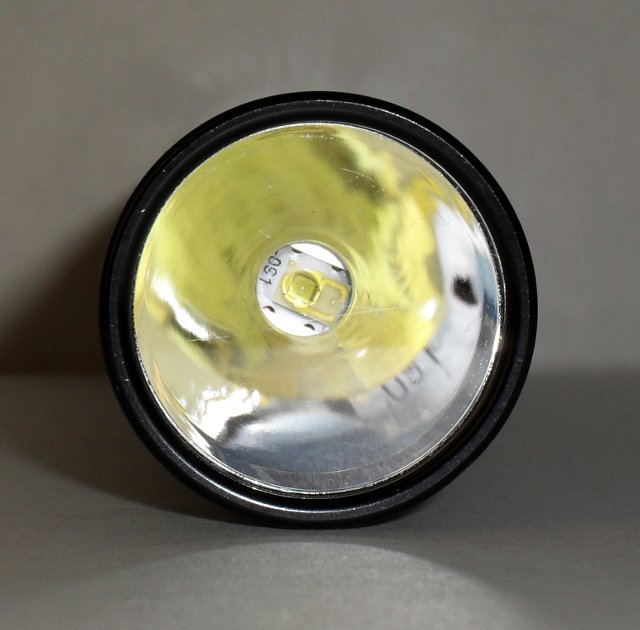
Powering Up.
As with most lights, this one does not come with the batteries
installed - you need to do that first. It's not too hard though,
just follow the instructions below:
1. Unscrew the tailcap (the end with the orange button on it) by
turning anticlockwise (if you're looking at it as if reading the text
there), and put it somewhere safe.
2. Tip out the battery carrier.
3. Insert three new AAA Alkaline batteries into the holder, negative
(-) ends towards the springs.
4. Reinsert the battery holder into the body of the light - there's an
arrow embossed (albeit rather faintly) in one side which indicates
which side should go in first. This is the side which has a
couple of pins on it, rather than the ring shaped terminals in the
centre and a single pin. If you insert it the wrong way, the
light will not operate.
5. Screw the tailcap firmly back on. That it, you're done.

Runtime testing on this light will take a while...as it has rather a
long rated runtime...so it will have to wait a bit until I've got the
odd five hours free to keep an eye on it!
Mag indicate that the light should run for around 5 hours on high, and
for around 200 hours on low.
The instruction manual specifically prohibits the use of rechargeable
cells in this light, however I have tested it using a set of rather
archaic NiMH cells with no apparent ill effects. These cells are
borrowed from a friend and have now been returned. I have nothing
which uses rechargeable AAAs, nor any way to charge them, so it's
unlikely that I'll be doing runtime testing specifically with
rechargeables - especially given that the instructions state they
shouldn't be used. In a pinch though if this is your only light
and they're the only cells you have handy...it appears that they will
work.
I'm no great fan of battery holders like this. Firstly, they make
it very hard to change the batteries in the dark, or if you have cold,
damp, greasy or gloved hands. Also, while this one appears to be
pretty sturdy, I have seen lights with holders like this where the
light has had to be scrapped after a few years because the holder has
fallen apart - though even if it did fail, the light does have a
lifetime warranty.
One change which I think could be easily implemented which would make
this rather more user-friendly though would be to implement some sort
of interlock to make it impossible to insert the battery holder
backwards. A couple of the Nuwai lights I have with holders like
this have done just that simply by having a tab at one side of the
holder at the top. If you try to slot the holder in the wrong way
around, it simply will not fit far enough in to screw on the
tailcap. Given how hard the arrow is to see, I think this would
be quite handy, not hard to engineer either.
User Interface.
Okay, this is where it gets interesting. My usual procedure
when getting a new light goes something along the lines of; open
package, pick up batteries which spilled all over floor, put batteries
in light, switch on, blind self, switch off, examine light, blind self
again, write review. Sometime after the first draft has been
written, I may actually look at the instruction manual. This was
a rare case of my actually having to look at the manual to work out how
to access the different modes.
If you want to use this light just as any other flashlight, it couldn't
be simpler. All you need to do is press that little rubber button
on the tailcap once until it clicks softly to switch the light on, and
again to switch it off.
I, like many other people spent the first five minutes looking at the
little notch on the rubber button and being convinced that it must
rotate to get to the different modes, and noting how awkward that
appeared to be...I was of course completely wrong!
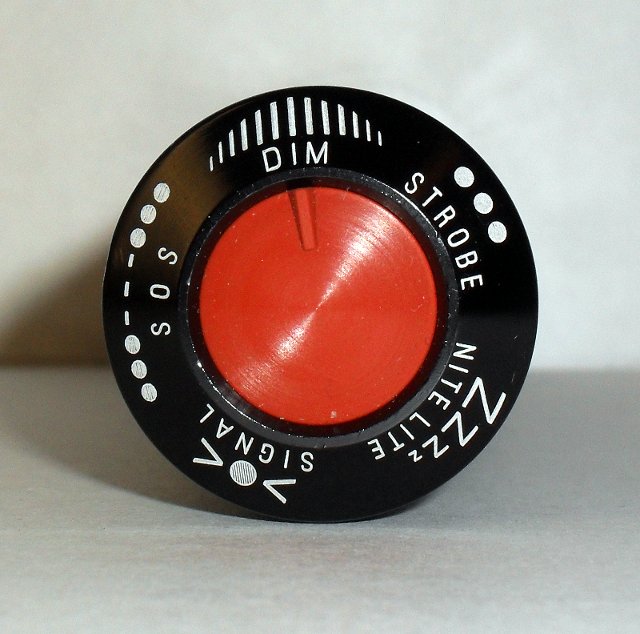
That little notch is there in no capacity other than to act as a frame
of reference for which way is "up" as far as the control circuitry is
concerned - because you see, this light has a motion sensor built into
it; this is the central part of its quite unique, and quite clever
control system.
The light has six modes - I'll tackle these one by one below.
Normal (dimming). Switch the light on with the
little
notch facing upward and the light held roughly level - but don't let go
of the button, while keeping it held down, slowly rotate the whole
light to the right or left. As you do this, the light will get
dimmer or brighter, just as though you were turning the knob on a wall
mounted dimmer switch for a ceiling light. Once you reach the
brightness level you want, simply release the button.
The light can be switched off once you're done with it simply by
pressing and releasing the button again as normal. Next time the
light is switched on by a "single click" it will come back on in the
last brightness level selected. Quite a bonus if you're in a
situation where you don't want to wreck your night vision, because you
can set the light at a low level and leave it there, knowing that when
you switch it back on that it won't dazzle you.
Strobe. Turn the light so that the marking which
shows "Strobe" and the three dots is facing upward, then press and hold
the button. The light will come on, and after approximately 1
second will start to flash. Turning the light to the right or
left will increase or decrease the strobe rate, and releasing the
button will then set the speed. This appears to be variable
between approximately 0.5Hz to about 10Hz. It's quite fast enough
to create proper stop-motion effects.
Nite Lite. Yes...That is how it's spelled on the
light...Maglite
apparently can't spell. Activate this mode simply by holding down
the button with that marker facing up, for about a second, the light
will blink very briefly giving an indication that the mode has been
selected, then you can release the button. If you then set the
light down somewhere stable, after being at rest for around 2 seconds,
the light will slowly dim to a very low "moon mode" and stay
there. If however you disturb the light (it's actually quite
sensitive) in any way by moving it, it will instantly return to full
brightness until it is left still for around two seconds or so.
This is actually quite a clever feature I think, and would be a real
bonus if the light were being used in an unknown hotel room for
example, or in a caravan or tent where you don't always have a shelf
handy in just the right place, or might not be entirely sure where the
light is. All you need to do is fumble for it a bit, and pretty
much as soon as you touch it, the room will light up.
Signal. You've probably caught onto how these
modes
are activated by now...Yep, this one's activated by turning the body of
the light so that the "signal" text is facing upward, then pressing and
holding the button. After a second or so, the light will switch
off. Once in this mode, rotating the light anything more than 45
degrees or so from vertical results in the light switching on.
Returning it to the "upright" position will switch it off again.
This I found to be a little awkward, but works much better if you hold
the head of the light in your other hand and use one just to
concentrate on rotating the light as shown below. Still though
think that a conventional button is actually easier for this function,
and that this may have been included more from a "we have the
functionality to do it...so we will" point of view rather than as a
genuinely useful mode.
SOS. Speaks for itself really doesn't it...I
wonder
if you can guess what this mode does? Yep - if you press and hold
the button with this symbol uppermost, the light will start to flash
out SOS in Morse code after a second or so. Rotating the light to
the right or left before releasing the button will increase or decrease
the brightness level - but has no effect whatsoever on the speed of the
flashing.
It's clear here isn't it, that there is a huge level of versatility
here? The unusual thing however is that it's been implemented in
such a way which does not in any way hinder the ease with which the
light can be used as a normal flashlight on a day-to-day
basis. You just click the button to get light, and click it again
to get no light...couldn't be simpler.
While it baffled me initially, I've come to think that this switching
system is really rather clever; not only that but the inclusion of
features such as the night light and dimmer are genuinely useful.
I can't see the strobe, signal or SOS modes being used particularly
regularly by the majority of users - though the SOS mode would be a
nice one to have I imagine for anyone who goes hill walking or similar
on a regular basis. Even if you never use it...it's nice to know
the feature's there. The strobe mode I can see being used mainly
as a poor man's substitute for an old fashioned xenon strobe light...No
doubt students will love it for dorm room parties...but I can't really
think of much in the way of practical uses for it!
All in all...despite its complexity, this is a very easy light to
use. Just read the instructions first, because it is quite unlike
anything you're likely to have encountered before and isn't immediately
intuitive simply at a glance.
Performance.
A few years ago, LumiLEDs were really dominating the high power
LED market with their Luxeon Star products, first in 1 watt form.
Shortly after, the 5W version came on the scene - despite eye-searingly
high lumen levels, this never attained quite the popularity as the 1W
models; difficulties in a lot of lights in dealing with the
considerable amount of heat produced, and focusing the beam from the
relatively large source may well have contributed to this. The 5W
part also had a relatively high working voltage, which further
complicated the challenge of creating efficient drive circuitry.
Later on, a 3W version of the Luxeon Star was released - this was
actually a more refined version of the original 1W part, with improved
thermal transfer characteristics from the die to the outside
world. This was far easier to focus due to the smaller optical
source than the 5W version, and was the first serious incandescent
beater which I first encountered in flashlights on supermarket shelves
rather than just those ordered from specialists. ...Which reminds
me, I really need to review that 3W one which I bought from Tesco last
year...
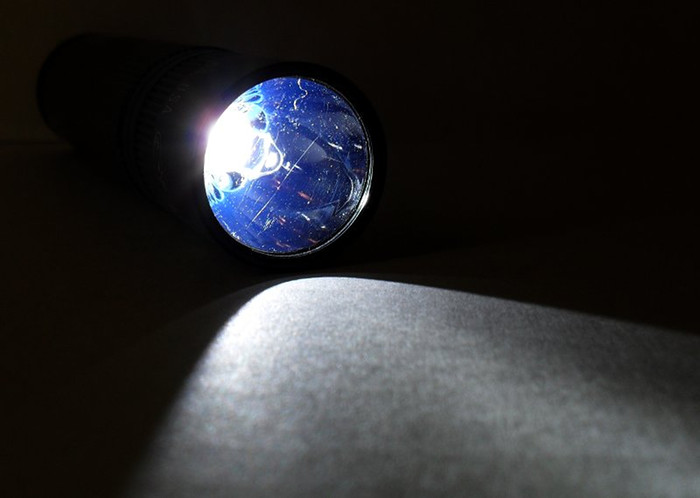
In the last couple of years however, a lot of competition has now
popped up in the high powered LED market, with Cree, Nichia, and ISP
Korea to name a few all having products on the market. The two
big boys in the fight though still seem to be Philips owned LumiLEDs
and Cree - I'm not going to say who's winning this battle as the moment
I type it, that information will likely be out of date.
This particular light is powered by a LumiLEDs Rebel LED which is rated
at 1W, however delivers considerably more light than the original
Luxeon Stars did thanks to an efficacy of 70+ lumens per Watt (I can't
say precisely what that is, as I don't know what the part number of
this emitter is, and it varies by part somewhat from a minimum of
70Lm/W up to a guaranteed 100Lm/W for some specially selected parts).

For all it's not a huge light, make no mistake, this thing is plenty
bright enough for any task that your everyday user is likely to want a
flashlight like this for. It's not going to light up that barn
half a mile away in the dead of night on your farm when you've heard a
noise there...but that's not what it's designed for. If you want
to do things like that, you really want a high power incandescent or
HID based searchlight. For walking the dog on a less than
perfectly lit road, wandering around a house during a power cut,
working in the loft, or crawling around under the car however, this is
more than adequate - even when not set to its highest power level.
While the packaging states that the beam is adjustable...just don't
bother! Adjusting it simply leads to the otherwise surprisingly
smooth beam becoming full of artifacts, slightly wider...and
dimmer! The default "fully tightened" position of the bezel
results in a good medium spot beam with a soft fall off to the sides -
a beam which appears to be a good balance for daily use.
As with most of their existing incandescent products, the bezel of the
light can be removed, and the light operated in "candle mode" if you're
wanting a broad spread of light to light a room or tent. I would
not recommend doing this however...While it works, it does lead to a
lot of glare, as the LED is a very bright point source - and in a room
with a light coloured ceiling I would certainly suggest simply standing
the light on its end (it has been designed so that it stands quite
happily with the reflector facing up) with the reflector in place as
usual and working
from the light bounced back from the ceiling. This gives you
nearly as much light, but without the blinding glare - it also means
tha the light retains its waterproofing and the LED remains protected,
as with the bezel removed this of course means that the LED is exposed
to the elements. Unlike "old fashioned" 5mm LED's which have hard
epoxy resin cases, the outer of the Rebel LED used as the lamp in this
flashlight is actually made of a soft silicone material. As such,
it is quite vulnerable to damage if exposed - and of course it's not
like you can just replace the LED like you can a bulb in an
incandescent flashlight...so even though you can...I would suggest NOT
removing the head. If you absolutely must, please be careful.
Unfortunately as I do not possess a light meter at this point in time, I
can't provide actual figures for the beam intensity, the photographs
below however should give you a good idea in real terms I would hope,
both with regards to power output and beam angle.
Beam Profile Images.
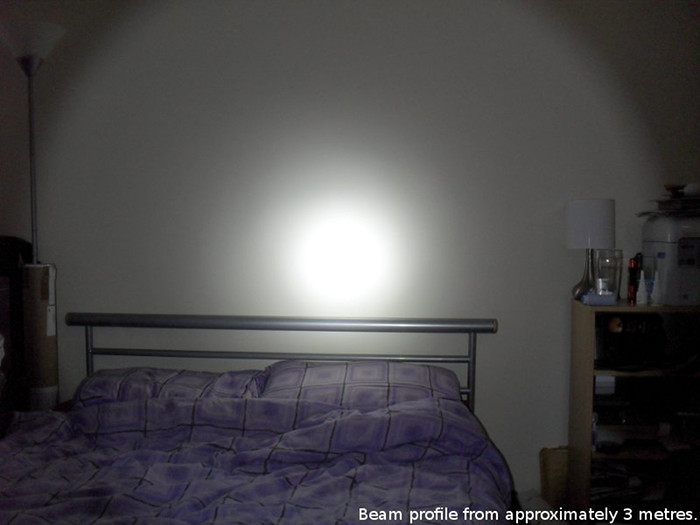
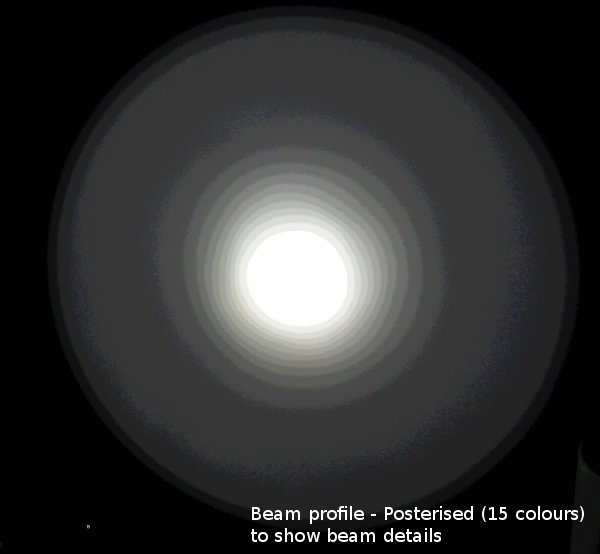
Please note that the off-centre beam above is an artefact of the
photograph due to the camera not being perfectly parallel with the
target rather than a defect in the light!
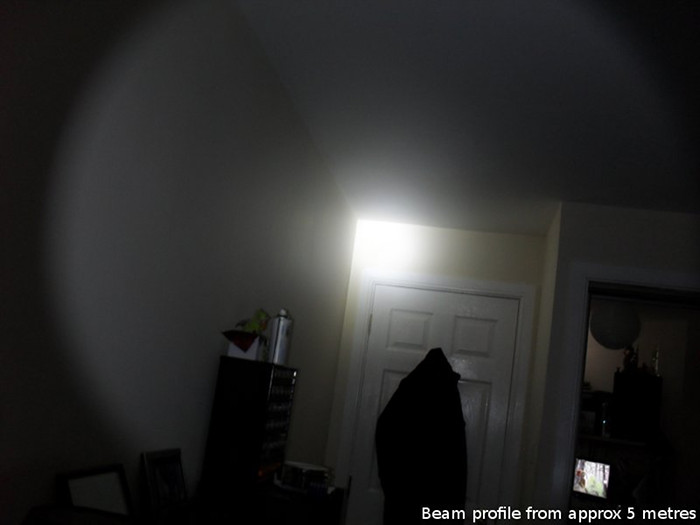
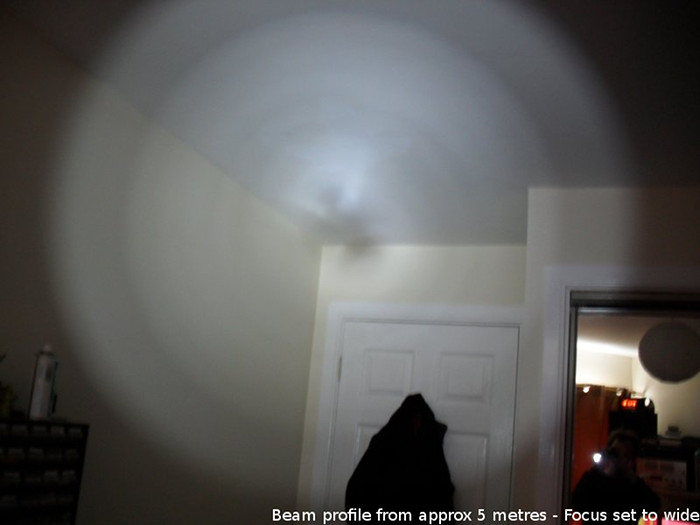
Ergonomics.
Mag have been making flashlights for a very long time...so they
should know a thing or two about making them easy to work with.
To be honest, I really can't argue with their previous offerings in
that regard, though the Solitaire could be a bit fiddly to use...that's
mainly due to the fact that it's so tiny though rather than poor design.

Ergonomically, it is very hard to fault this light, especially if
you're using it the way that I expect that the vast majority of users
will - and that's in normal (click on, click off) mode.
It's comfortable to hold in a variety of ways, though the button can be
a little stiff to press with your thumb sometimes, with the light
tending to try to slide through your fingers - so I tend to rest my
index finger on the button rather than my thumb, especially when
holding the light in a tactical style grip as shown below.
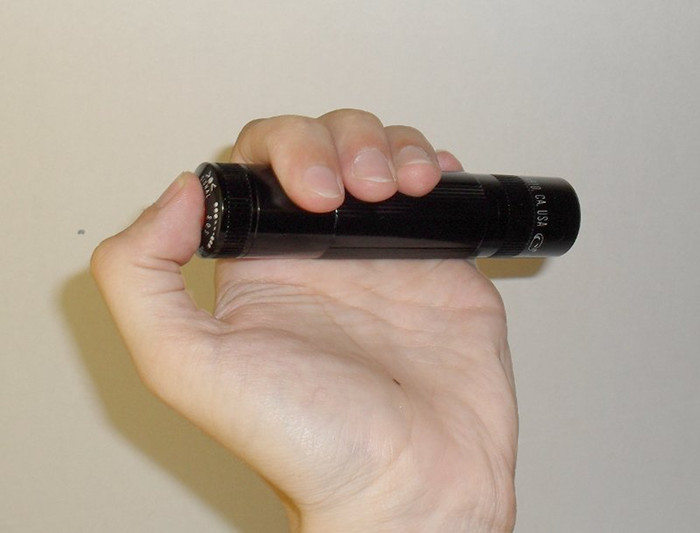

Retention is aided by longitudinal grooves cut into the body of the
light, head and tailcap. While this is helpful when trying to
fasten or release the tailcap to replace the batteries, it doesn't
actually do a huge amount in terms of helping you to actually stop the
light sliding out of your hands in the direction of the grooves
unfortunately. This is especially true if you're only holding it
between a couple of fingers, as is quite often the case I find when I'm
using a flashlight to peer into some dark, inaccessible corner of a
cars engine bay.
The conventional knurling on the likes of the MiniMag range do a great
deal better job of actually keeping the light in your hands I find.
This is compounded by the fact that there is no provision made
whatsoever on the light for the attachment of a lanyard...so if you do
drop it, it's going to keep going until it hits the ground, gets wedged
down the back of the engine block in your car, or goes bouncing off
down the mountain path you're walking along.
On the subject of losing hold of the light...I've managed to lose
track of it in my room several times already, including while I was
actively trying to take photographs of it for this webpage. On
every occasion this was because it had rolled off from where I'd put
it. ...This light is particularly fond of rolling, and being
pretty much a perfect cylinder - it will keep going in a nice straight
line until it falls off wherever you've put it. I have heard that
there is actually an anti-roll device available for the 2AA MiniMag
which fits over the end of the light - this will apparently also fit on
the XL100, which would at least put an end to its Houdini like ability
to disappear the moment you put it somewhere more than a tenth of a
degree from perfectly flat and take your eyes off it for more than two
nanoseconds.
The lack of actual knurling on the body of the light is actually a bit
of a bitter-sweet thing, one which more thought may have actually gone
into than I was initially giving Mag credit for. This is a light
which is going to lend itself to being carried around in peoples
pockets - and aggressive knurling I know from my own bitter experience
is very good at one thing: Destroying pocket lining! This design
while less grippy than a light with proper knurling is still a heck of
a lot easier to hold on to than it would be if it was just plain, shiny
anodized aluminium - but is also pocket friendly.
Please Maglite, if you're reading this...when you release a new version
of this light, give us a lanyard attachment point...and if at all
possible, use that as an anti-roll device too.
Now, using the different modes...Being at least to me a completely
new
interface system, I had to experiment a bit to find a properly
comfortable way of using it. You'll quickly find a combination
that works though, the different options I've shown here are just those
which I tend to use myself.
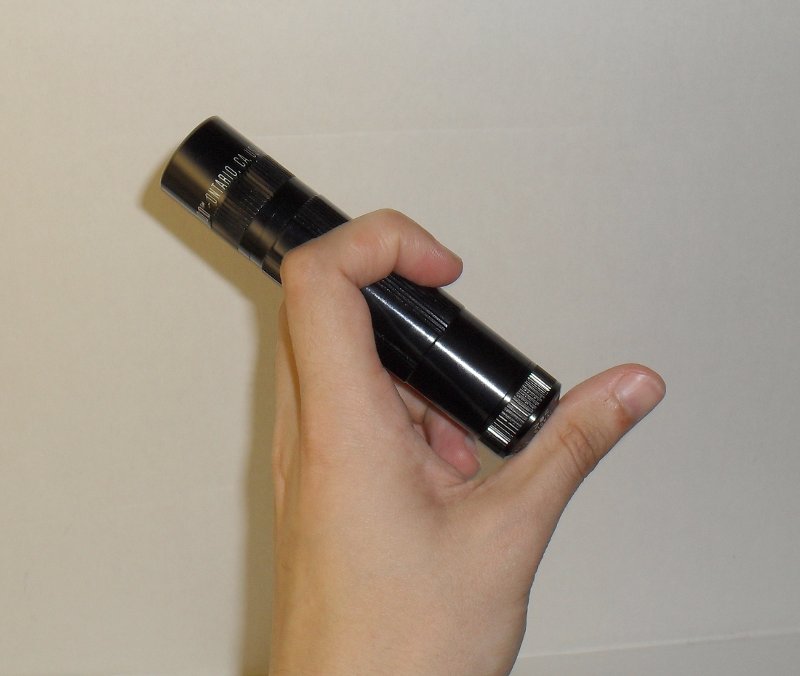
It's by no means impossible to do this one-handed holding the light
like in the next picture, but you may struggle with this slightly if
you've got weaker hands, as it does take a bit of effort to maintain
the pressure on the button, hold the light in your hand (bearing in
mind its tendency to try to slide out of your hand when you press the
button), and then twist your wrist to rotate it. While it's an
innovative system...ergonomically speaking, it's not
perfect...Comparing it though to some other control systems I've seen
on multi-mode lights, it still gets the thumbs up I think. I think the
biggest plus it has is that while there are a bunch of modes available - they
don't actually get in the way of the "click-on, click-off" function which you're
going to use 99.9% of the time.
Durability Department.
Now this has always been the party piece for LED lights, as the actual
lamp itself is for all intents and purposes, impervious to shock.
Assuming that the body is up to it you could literally play football
with an LED light and it would not care in the slightest.
...Well, you'd have to work out some way to make it roll and bounce
like a football I guess as well...but that's just being picky...
Durability wise, Mag's only ever really had one real issue, and that
was the simple fact that they were based on tiny little xenon
incandescent bulbs, which were obviously by their very nature quite
sensitive to shocks. Dropping a light onto a hard floor for
example would more likely than not result in a popped bulb. The
actual build of the lights though has generally been very good - one
reason that they have long been a favourite for modders to use as a
basis for one-off lights and for upgrade packages.
Based on this history, and my first impressions of the light itself, I
don't foresee it having any issues. Still...let's see if I'm right!
The anodizing on this light I would have expected to be type 2 hard
anodizing, which is a bit harder than most paint finishes and doesn't
flake off in chunks as paint will tend to when scratched.
Attacking the area underneath where the bezel screws on (so it's out of
sight!) with the tip of a key left a small scratch, which confirms this
suspicion. This is a pretty hardy finish which on a light which
is used around the house is likely to look like new aside from the odd
nick for years. If it's kept in a toolbox or something though, it
will wear away quite quickly - though this will not in any way affect
the functionality of the light, it will just mean that it looks a bit
more beat up.
The weak component in terms of the outside of the light I am certain is
the lens. This is made of pretty soft plastic and is quite thin,
if anything is going to get scratched up badly even in gentle use, this
is it. If this is a real worry for you, or your lens does get
badly scratched up, a few sources I've found online have indicated that
the glass lens for the MiniMag 2AA will fit correctly in this light
(part #108-617). The only worry about that however, is that the
lens in this light is held in place by the reflector - this is a
pressure fit inside the head. This means that to get it out, you
have to apply pressure on the lens, and wobble the reflector from side
to side in a highly technical manner until it drops out. Given
that it really is quite a tight fit in the head, there seems to be
quite a possibility that the reflector could be damaged during this
process...so if you do decide to replace your lens, please be careful.
The second potential weakness which would spring to mind would be the
rubber boot over the button on the tailcap. This actually appears
to be made of pretty tough rubber, so I think will stand up to normal
levels of use and abuse without any problems.
While the metal that the body of the light is made of is not hugely
thick, being honest it doesn't really need to be. This is a
flashlight which is designed to take the rough and tumble of everyday
life, not a military grade light which has to be designed to take a
trip to Hell and back via the bottom of the Laurentian Abyss without
any possible chance of failure, and that needs to be kept in
mind. As far as domestic lights go, this thing is sturdy - I'm
not about go go running it over with my car as I am sure I could easily
do with some of my other lights, as I suspect it may not stand up to
that - but I think you're going to have to do something pretty special
to actually damage the body.
The one concern which some people seem to have raised regarding this
light is with regards to the motion sensor in this light, and whether
it may be susceptible to damage from severe shocks. A number of
other reviewers however, and a couple of threads on Candle Power Forums
seems to suggest however that this component is actually a lot hardier
than we might have expected and actually very seldom gives trouble.
So, let's do the usual shock testing and such then...
Whacking the light firmly against the side of my desk, five times
against the tailcap and five times against the bezel, aside from a
funny look from someone outside at the noise didn't do anything at all
other than leave a dent in the side of the desk.
The "dropping from waist height" test is really just a formality...as
the light has rolled off my desk at least five or ten times already and
survived! This was done in the kitchen as a test as it has a
tiled
floor - the worst enemy of anything vaguely shock sensitive as it is so
completely unyielding. It shrugged it off without any problem
whatsoever.
The third and final kinetic energy test was done on a thinly carpeted
wooden floor, when the light is thrown with moderate force across the
room from waist height, as if to emulate the light slipping out of your
hand while running. This was repeated three times with no
failures to report.
With regards to water resistance, the light is advertised as water
resistant, not waterproof. This means that it's intended to
survive getting wet, but isn't intended to actually be submerged.
All components were tested and found to hold a vacuum, however reports
have indicated that if the light is submerged that water will tend to
very slowly seep in around the perimeter of the lens - the only part of
the light which is not visibly sealed with an O-ring. The light
was left laying on its side in the shower for half an hour to emulate a
reasonable length walk in a rainstorm - afterward there was no sign of
moisture found within the light. So while I would suggest against
going swimming with it - this light seems to be quite capable of
surviving a trip out in the rain. To ensure that this remains the
case, make sure that every few months that you lubricate the O-rings
with a silicone based lubricant - no need to use too much, just a
couple of drops will do.
I am quite confident that this is a light which will pull all the
punches that everyday life is likely to throw at it, plus some more to
be honest. Just don't go diving with it.
Overall.
As I said at the very start of this review, it was one which I was
approaching with some trepidation. Especially in light of the
switching system which sounded from the packaging very much like a
gimmick which was going to be completely useless in the real
world. I was however willing to give it the benefit of the doubt
and try it.
I think in all honesty that Mag have a product here to be proud
of. They've managed to pull off a fantastically difficult feat,
which is designing an interface which manages to give access to
advanced features, but does it in such a way that they do not in any
way, shape or form get in the way of day-to-day use of the light.
It's bright, it's got a perfectly balanced beam, it's comfortable to
use...C'mon Mag - give us a decent lens out of the box and a lanyard
attachment point and you'd have a perfect light here...
Well done guys!
Pros:
+ As close to a perfect combination of advanced/basic features as I've
ever seen with an interface that works.
+ Bright for its size.
+ Very usable beam pattern.
+ Uses cheap, readily available batteries.
+ Comfortable to hold.
Cons:
- Poor quality lens, completely at odds with the rest of the light.
(There goes two points)
- No anti-roll device or lanyard attachment point (one of these two
would drop it off the cons list...but a lack of both leads to a
potential for the light to get lost!)
Niggles:
> Night Light mode always jumps to full power - it would be nice to
be able to set this to a preset level to avoid completely zapping your
night vision the moment you touch the light.
> Battery holder is fiddly to change in the
dark or with cold/gloved hands.
> Shame that it's not fully waterproof
given how little extra work it would take.
Ratings:
Beam Quality: 9
Build Quality: 8
Battery Life: 9
Durability: 8
Value: 10
Overall: 44/ 50 = 88%
Long Term Testing:
5th July 2010: Review uploaded. This is a light which has gone
straight into daily use as a result of its convenient size and ease of use, so
if anything untoward or of note happens to it, I'll be sure to update the page
as appropriate
5th January 2021: Page retired and moved to Site Archive.
25th January 2021: Minor changes to page formatting to improve usability on mobile devices.
28th April 2023: Revised Statcounter code to allow for HTTPS operation.